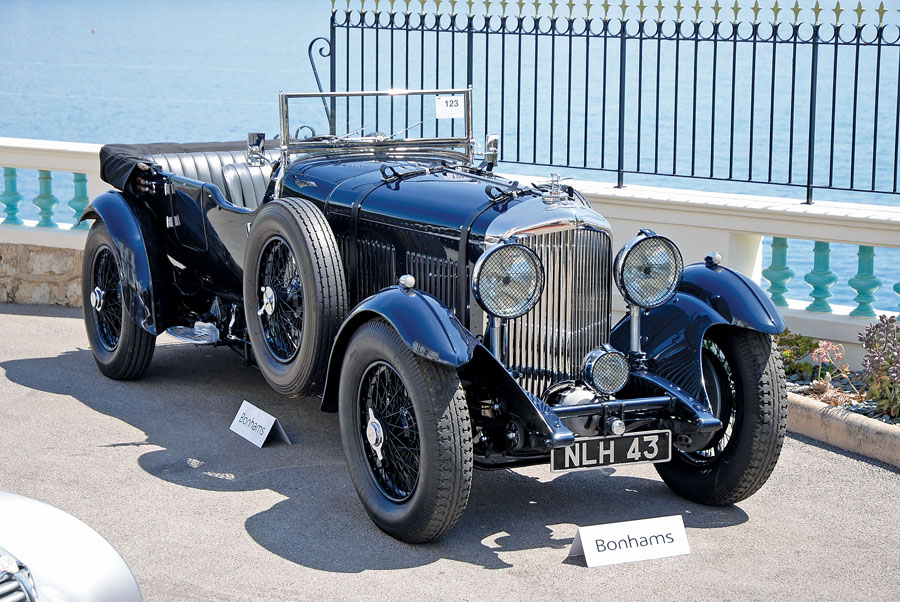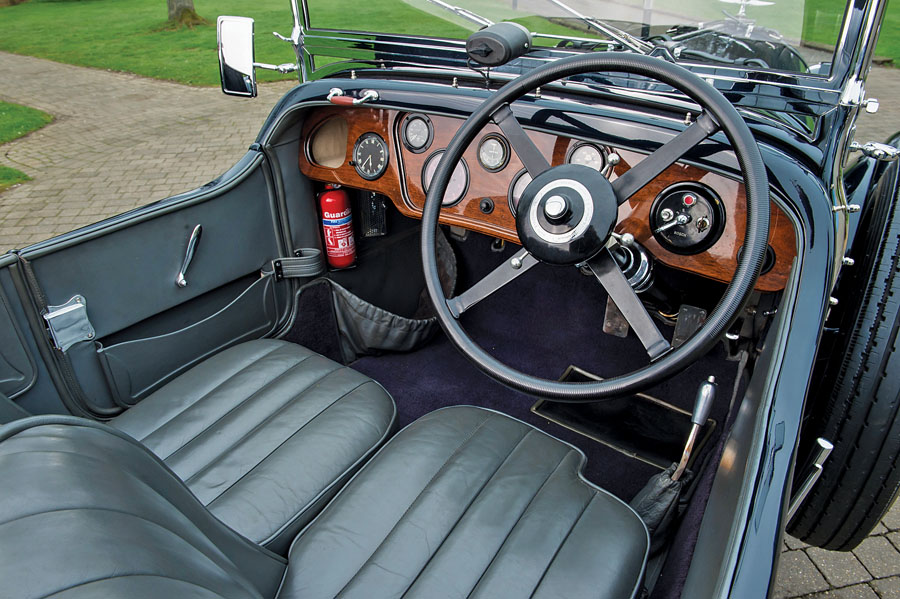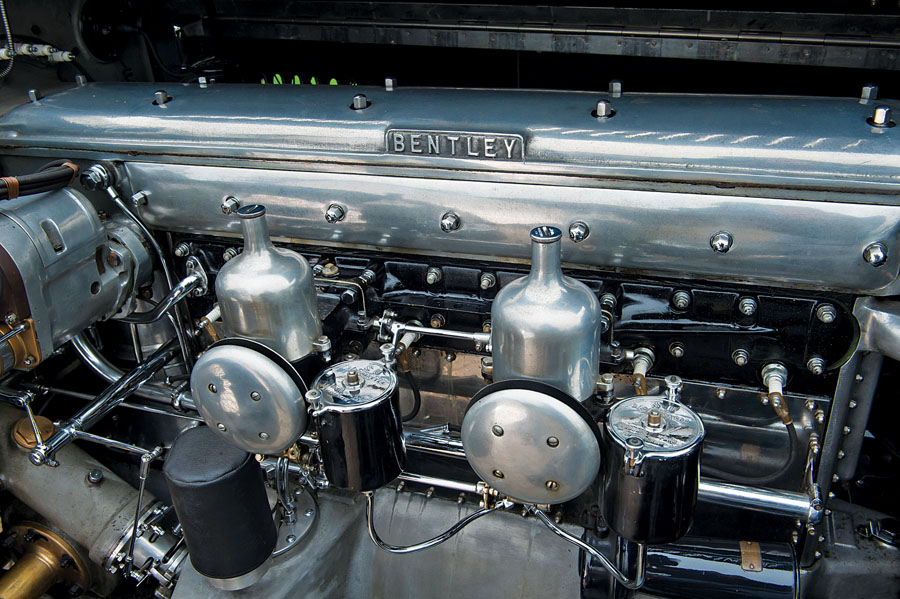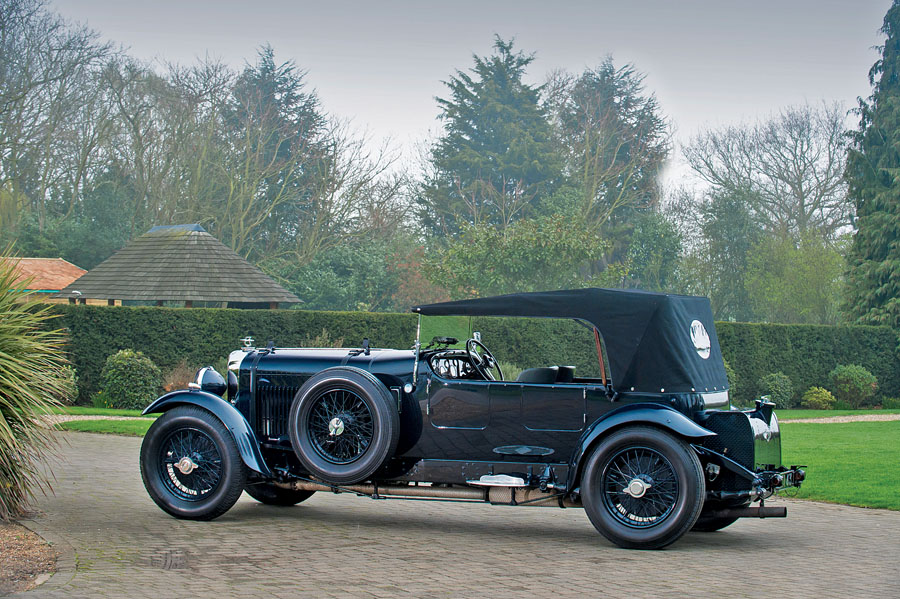SCM Analysis
Detailing
| Vehicle: | 1931 Bentley 8 Litre tourer |
| Years Produced: | 1930–32 |
| Number Produced: | 100 |
| Original List Price: | £1,850 (rolling chassis) |
| Chassis Number Location: | Ledge on left of bulkhead |
| Engine Number Location: | Stamped into engine bearer integral with crankcase |
| Club Info: | Bentley Drivers Club |
| Website: | http://www.bdcl.org |
| Alternatives: | 1929–36 Rolls-Royce Phantom II, 1924–29 Hispano-Suiza H6C, 1930–38 Mercedes-Benz 770 Grosser (W07), 1930–32 Packard Eight |
| Investment Grade: | A |
This car, Lot 123, sold for $885,104, including buyer’s premium, at Bonhams’ Monaco auction on May 11, 2018.
“Motoring in its very highest form,” eulogized The Autocar in December 1930, having recorded a top speed of 101.12 mph over the half-mile in W.O. Bentley’s own saloon-bodied 8 Litre.
Although one thinks of Cricklewood Bentleys as sports cars and fast tourers — particularly with the number of Vanden Plas-style rebodies that proliferate today — don’t forget that it wasn’t all about winning at Le Mans. W.O. Bentley also wanted a piece of the carriage trade.
The 6-cylinder 4 Litre, 6½ Litre and 8 Litre models were developed to carry heavier bodywork. The 8 Litre was able to crack the ton — even with formal coachwork that could bring the weight up to 2.5 tons.
Bentley managed to build only 100 8 Litres before bankruptcy struck. The chassis price of £1,850 was in direct competition with the Rolls-Royce Phantom II — but with better performance. The contemporary motoring press was lavish in its praise.
At 7,983 cc against the Phantom’s 7,668 cc, the 8 Litre was the largest-engined car made in the U.K. at that time — and the fastest. As W.O. himself said, “I have wanted to produce a dead-silent 100-mph car, and now I think we have done it.”
STONK for days
The 8 Litre engine is essentially an evolution of the 6½ Litre. Ever the hot-rodder, W.O. Bentley followed his long-preferred method of improving performance by simply adding cubes.
Engineers punched out the bore size of the four-valve SOHC “Six” from 100 mm to 110 mm, although stroke remained at 140 mm, which gives a clue as to the engine’s character.
All this necessitated a stronger gearbox — the F-type.
Although racers favor the 4-cylinder Bentleys — the cars that won at Le Mans in 1927 and 1928 — the larger 6-cylinder cars have two things going for them: sheer presence and stonk. Or, more properly, STONK.
The 8 Litre makes “only” around 200 bhp at 3,500 rpm; these have a compression ratio of just 5:1, which, along with the long stroke and heavy flywheel, means lots of soft, tractable pull from almost zero revs — picture an electric motor.
One Bentley engineer I spoke to estimates 340 ft-lb of torque with “the perfect torque curve” — pancake-flat — because from the wheel it feels as if you could pull down a house, rendering the gearbox largely redundant. Once you are into top gear, you more or less leave it there, which is just as well because Bentley gear changes can be challenging.
A few years ago, I found myself conducting a short-chassis 6½ Tourer with an 8 Litre engine through Hyde Park in central London.
Then the selling dealer sitting alongside suggested that a burst of enthusiasm would be in order. From less than 1,000 rpm and without changing down, the alacrity with which the car took off immediately impressed, soon surpassed the “a little unsettling” mark, and we backed off once the gauge hit “extreme nervousness,” having considered two tons of still-accelerating Cricklewood metal, drum brakes and proximity of other traffic.
At least on the 8 Litre the pedals are conventionally placed — instead of center throttle as on earlier cars — which leaves you one less thing to think about.
Our subject Bentley 8 Litre
At the auction viewing, this imposing tourer certainly looked magnificent glinting in the Mediterranean sun and right at home overlooking Roquebrune Bay out front of the Villa La Vigie, a former home of Karl Lagerfeld just outside the Monaco principality.
The body was dead-straight, the paint and chrome still magnificent and only the instruments, fading to purple — plus slightly broken-in leather — gave away that it hadn’t been minted the day before.
Even the leather spring gaiters looked new.
One car, several bodies
Our subject car has had quite a storied life, but that’s not unusual for any “W.O.” Bentley, many of which have so far worn two or three different bodies.
Peter Morley, who once owned and raced this car, having shortened the chassis (accounts vary by how much, from 10 feet, 10 inches to 11 feet, 6 inches), also owned an 8 Litre fitted with a 24-liter Napier Lion W12 (driving through the original Bentley gearbox) and monoposto bodywork.
That car still races today with Chris Williams. Williams has another 8 Litre chassis which runs a 42-liter Packard V12 motor torpedo boat engine. She’s called Mavis, and with her 24 stub exhausts, when he starts her up, you can watch one end fire up before the other… The point is, these 8 Litres are stout old things.
The car’s owner in Singapore was Mr. Eu Tong Sen, one of Malaysia’s richest businessmen, who used it to visit horse races with his girlfriends, with the result that the Bentley became known as “the Harem Saloon.”
During World War II, it was hidden away in one of Tong Sen’s mines, but its owner died of a heart attack in 1941. According to an earlier catalog entry, Pope’s Garage of Anson Road in Singapore had some time earlier built and installed a cocktail cabinet in the car, and it was Freddy Pope who arranged the car’s shipment back to the U.K. circa 1951.
The catalog said that the chassis had been relengthened to its original 12-foot wheelbase, which is the shorter of the two options offered (65 of the 100 were on the 13-foot chassis). Michael Hay’s book Bentley: The Vintage Years says it was re-lengthened in 1993 by Posnett. A photo taken in 2002 shows it still without a body. The rebuild and restoration took place soon after, and it remains in exemplary condition — even after several trips to Le Mans.
Sales history
It had been for sale at The Vintage Workshop in April 2016 for £850k (then $1,205,000), before the ask was dropped to £780k ($1,025,000) in August of that year, still about $140k more than it fetched at Bonhams’ Monaco auction.
The owner, who’d commissioned the rebuild 14 years earlier, was 78 then, and said that that he would like to pass the car on to a new custodian, “so it may be used to its full potential.”
After that it was offered at Coys’ True Greats auction in London on December 5, 2017, estimated at £700k–£900k ($940k–$1.2m), but it failed to attract a buyer.
The price paid here, $65k under the 2017 lower estimate, appears to have been a post-auction deal, as it didn’t sell on the hammer and was not listed in the online results immediately after the sale.
With buyer’s premium at 15%, the all-in price is equivalent to a top bid of $770k. That is $185k below Bonhams’ lower estimate, which is usually near the reserve price.
So the price has progressively dropped by £200k ($300k) in the two years it’s taken to get it sold. It’s worth noting that the 2016 asking prices straddle the time of the U.K.’s vote to leave the European Union on June 23, upon which the pound sterling immediately tanked by 15% — and quite a few owners decided they needed to get out of their collector cars in a hurry in case things got even worse.
That’s not the issue here. I think the reason this 8 Litre is relatively cheap is that it’s well known to have been a special. Now, 16 years since transformation into its present state, it is still a relatively new build — and it looks like one.
Any nuances and memories of its interesting former life have been lost along with its limousine body. If you want original coachwork, a fair few of the 80 8 Litres remaining still wear their first bodies.
At least Bonhams got the deal sealed where nobody else had succeeded. Surely the point of an auction is to bring seller and buyer together into a mutually acceptable arrangement. Job done.
In a parallel universe, I would have loved to see what it would have made had it not been chopped into a racer and had its original “Harem” body still fitted — cocktail cabinet and all. ♦
(Introductory description courtesy of Bonhams.)



